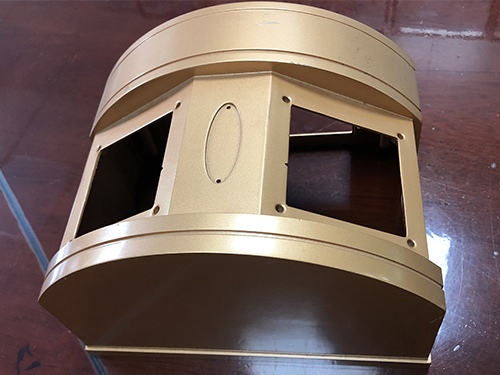1. Formwork

1. The outer surface is required to be bright and flat. Two punch holes are added to the front and rear mold frames. Pay attention to the places where there are no inserts to prevent the parts from falling out.
2. The A.B plate mold frame is matched with each other to make 0.1-0.15, and a flying water baffle is added to prevent the aluminum from flying out and hurting people.
3. In order to prevent the template from deforming, at least make two support columns, one on the shunt cone, and one on the shunt cone. Be careful not to interfere with other parts.
4. The mold adds 2-4 middle brackets and middle brackets, and the middle bracket side is best made with a limit.
5. The bottom plate of the mold must be open to facilitate heat dissipation.
6. The four corners of the mold should be cut to prevent it from hitting the green post during installation.
7. The inner hole table of the positioning ring is required to be nitrided after internal grinding and polished along the ejection direction.
8. The length from the bottom of the cooling ring on the surface of the positioning ring to the surface of the splitter cone is generally equal to the thickness of the cake. There are two ways to fix this cooling ring: welding and heating and pressing.
9. The shunt cone must be cooled by transporting water, and 25-30mm away from the surface of the shunt cone.
10. The four guide post holes of the mold base should be prying grooves with a depth of 8-10mm.
11. The mold base must be quenched and tempered, preferably a forged mold base.
12. In order to facilitate the removal of the inserts of the inner mold, a hole can be added on the surface of the mold, and then a few headless screws can be collected, so that it is convenient to disassemble and replace the inserts.
13. The hoisting holes must be at least M30 and 45 deep, and at least 2 at the top.
14. The external slingshot must be equipped with a spring protective cover to prevent the spring from deforming.
15. The surface that is higher than the surface of the mold base and needs to be in contact with the ground should be added with support columns.
2. Inner mold, insert
1. Do stress relief treatment before heat treatment after processing. General aluminum alloy quenching HRC45+/-1°C, zinc alloy quenching HRC46+/-1-1°C
2. The fit tolerance of the inner mold: Generally, it should be about 0.05-0.08mm smaller than the mold frame, and it can be easily taken out and put into the mold frame with a lifting ring.
The thimble fit tolerance: the thimble clearance of greater than or equal to 8mm is 0.05mm,
The thimble gap of less than or equal to 6mm is 0.025mm.
3. All right and acute angles on the inner mold must be over R0.5mm.
4. Use flat-blade screws to block the excess holes on the surface of the inner mold.
3. Runner and slag discharge system design
1. The main flow path of the fabric cake on the shunt cone should be within 1/3 of the surface area of the circle. In this way, the parting surface is closed before the cold material quickly enters the cavity.
2. The main channel above the split cone should be made into a "W" shape, and the thickness of the cake should be 15-20mm.
3. Generally, the length of the main runner should be 30-35mm, and the mold should be 5-10° on one side.
4. Generally, the cross flow channel is best to bend and make more than 2 steps to prevent the cold material from entering the cavity through the cross flow channel, resulting in cold barrier lines on the surface of the product.
5. Generally, it is best to add 2 buffers at the gate position where the cross flow channel enters the product, so that the cold material is completely blocked out of the cavity.
6. In general, the level of the thimble under the main runner must be moulded, and it must be above R2.
7. The protruding core on the opposite side of the main runner must be avoided, and the slag bag on the opposite side of the main runner should be garbage first, and then open according to the situation.
8. The slag bag is best to use the plane of the court, the cross-sectional shape of a semicircle, and the water inlet and the exhaust groove are separated by 1/3. The water inlet of the slag bag should also be skipped.
9. The exhaust slot should be discounted and smoothly transitioned, following the rules of "3.2.1".
10. In order to facilitate processing, the gate at the junction of the direct flow channel and the product should be skipped, and it is not easy to lose meat during post-processing.
4. Core pulling mechanism
1. The slider must be made with at least one hanging die hole on the upper and lower surfaces to facilitate disassembly and assembly.
2. The bottom of the slider should be a cutting trough, and the wear-resistant strip should be made into 2 pieces of 8-12mm higher than the bottom mold base surface to facilitate the cleaning of aluminum slag during production.
3. The bead of the slider should be a wear-resistant groove, which is 45° with the core pulling direction
4. The sliding mechanism should be flexible in guiding and sliding, stable in movement, with a clearance of 0.08--0.12MM.
5. After the mold is closed, the slider and the locking block should be pressed tightly, the contact area is not less than two-thirds, and has a certain prestress.
If you'd like to speak to a member of the Anebon team for Aluminum Casting,CNC Machined Custom Service,CNC Turning Alloy, please get in touch at info@anebon.com
Post time: Feb-25-2021

